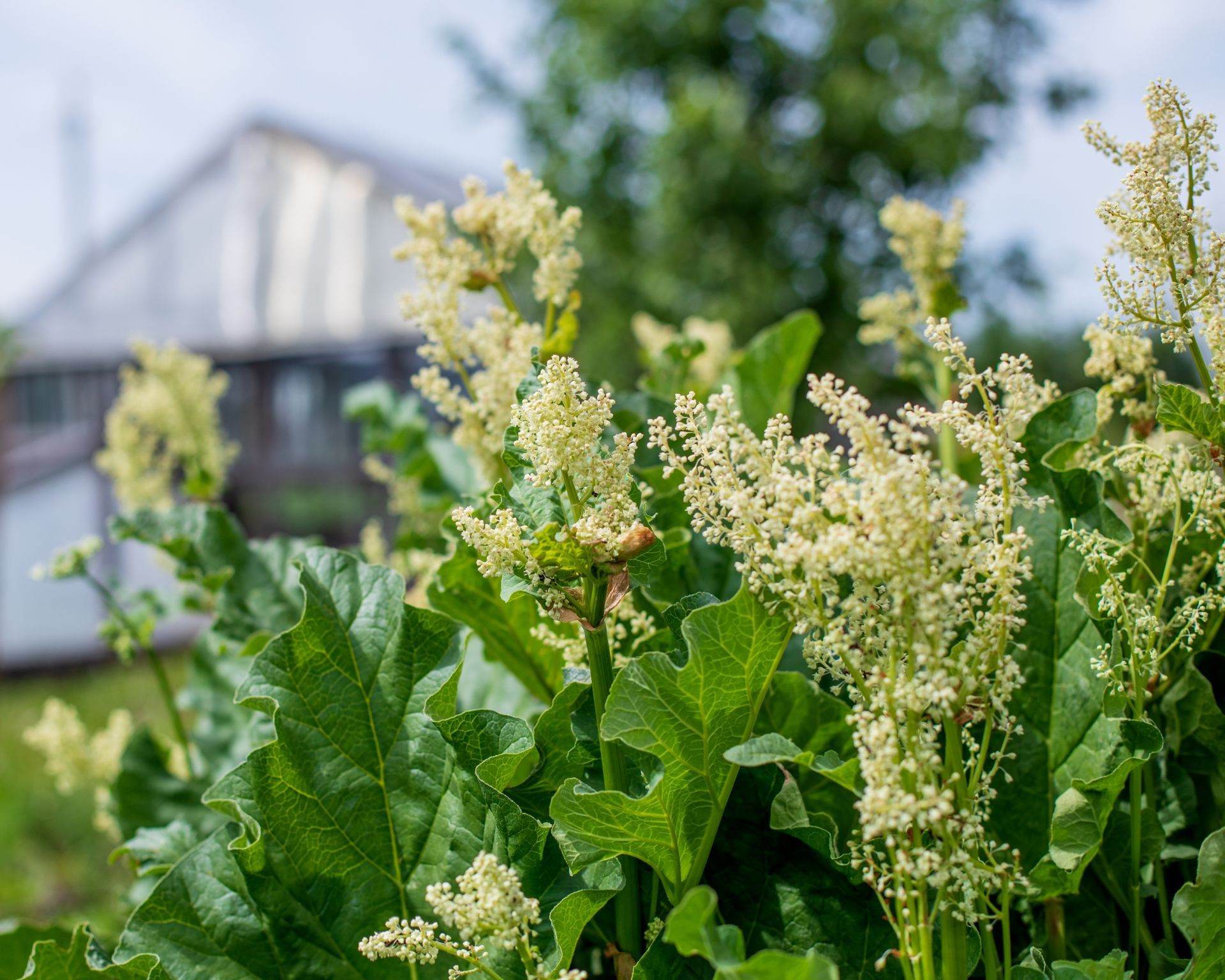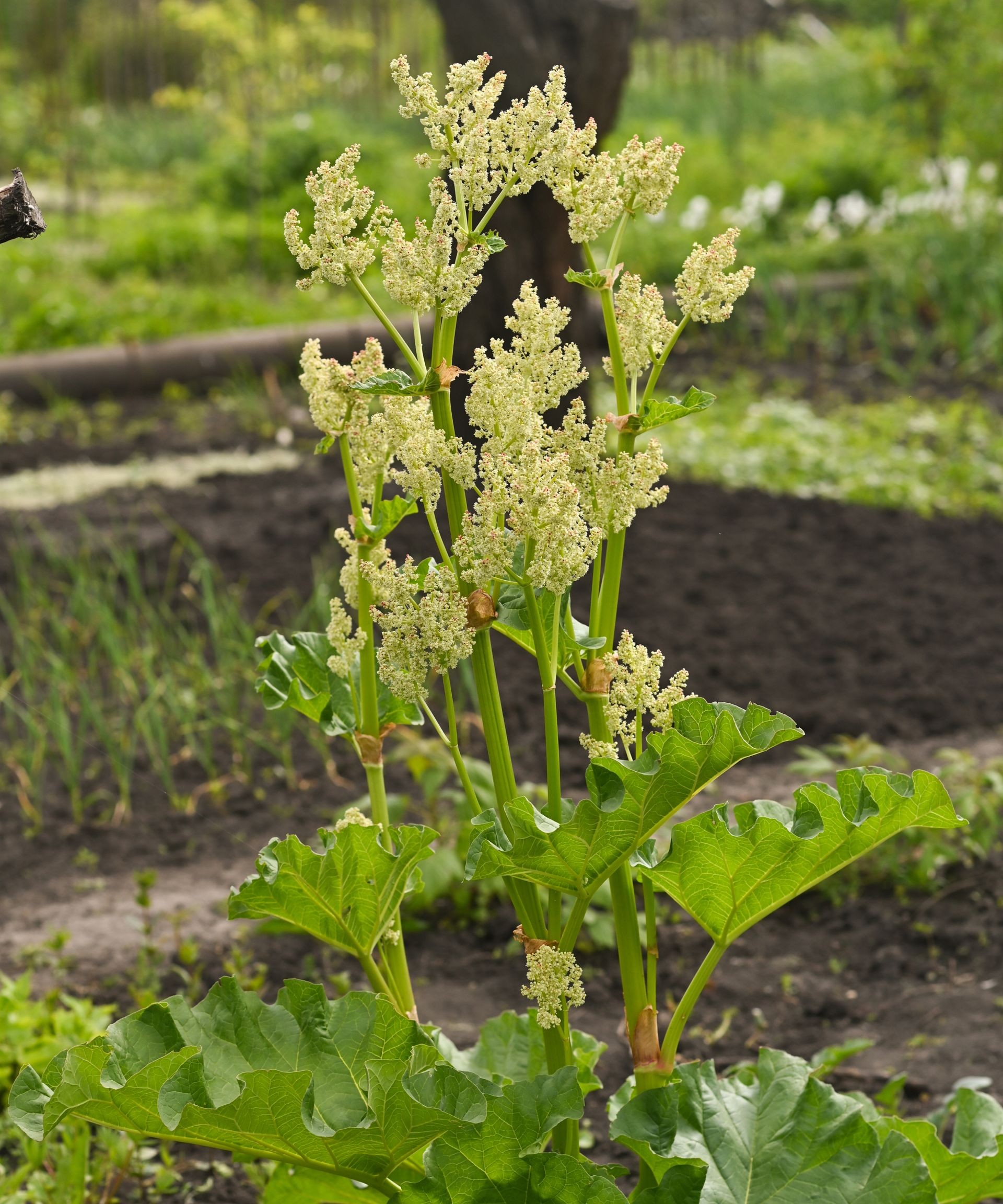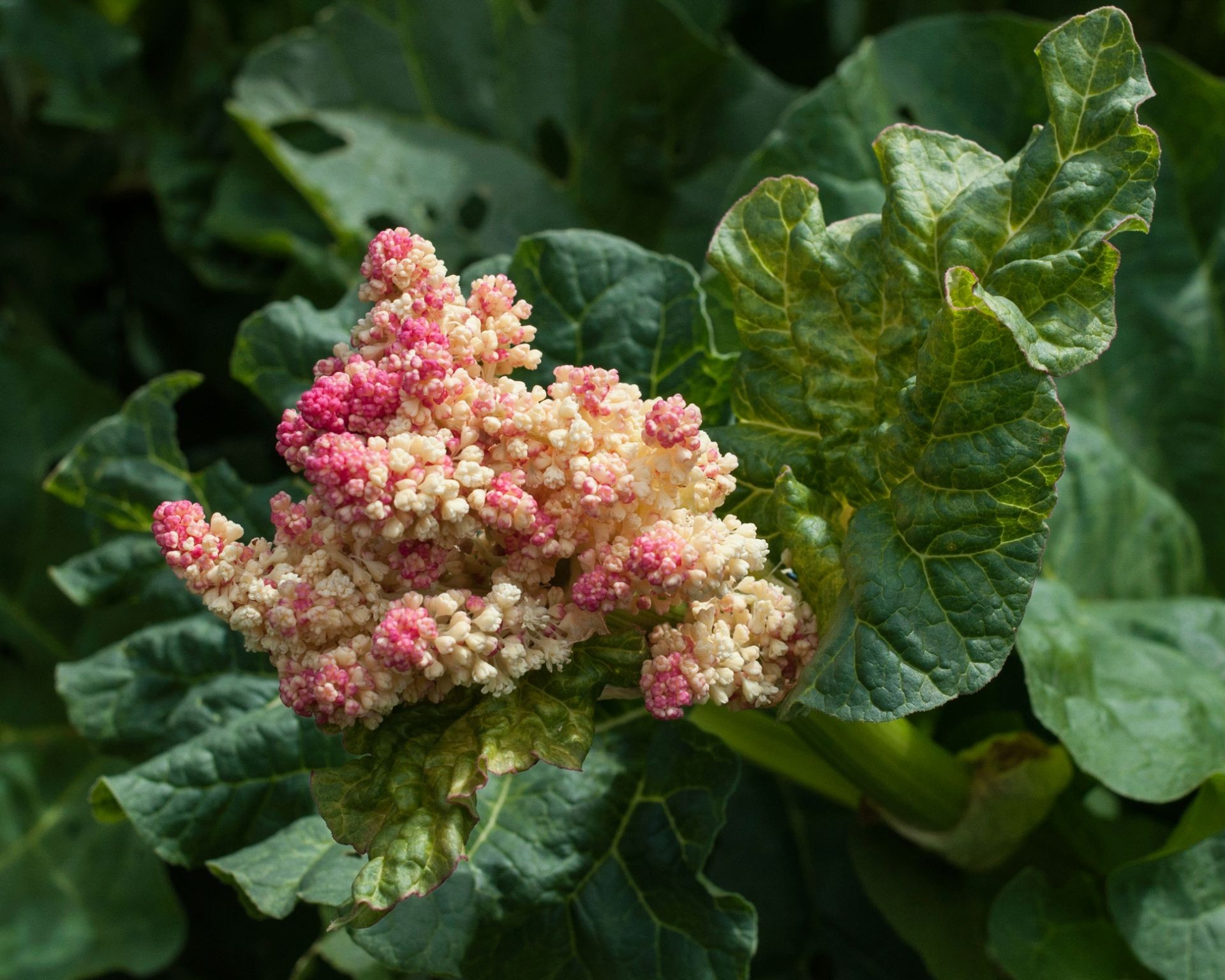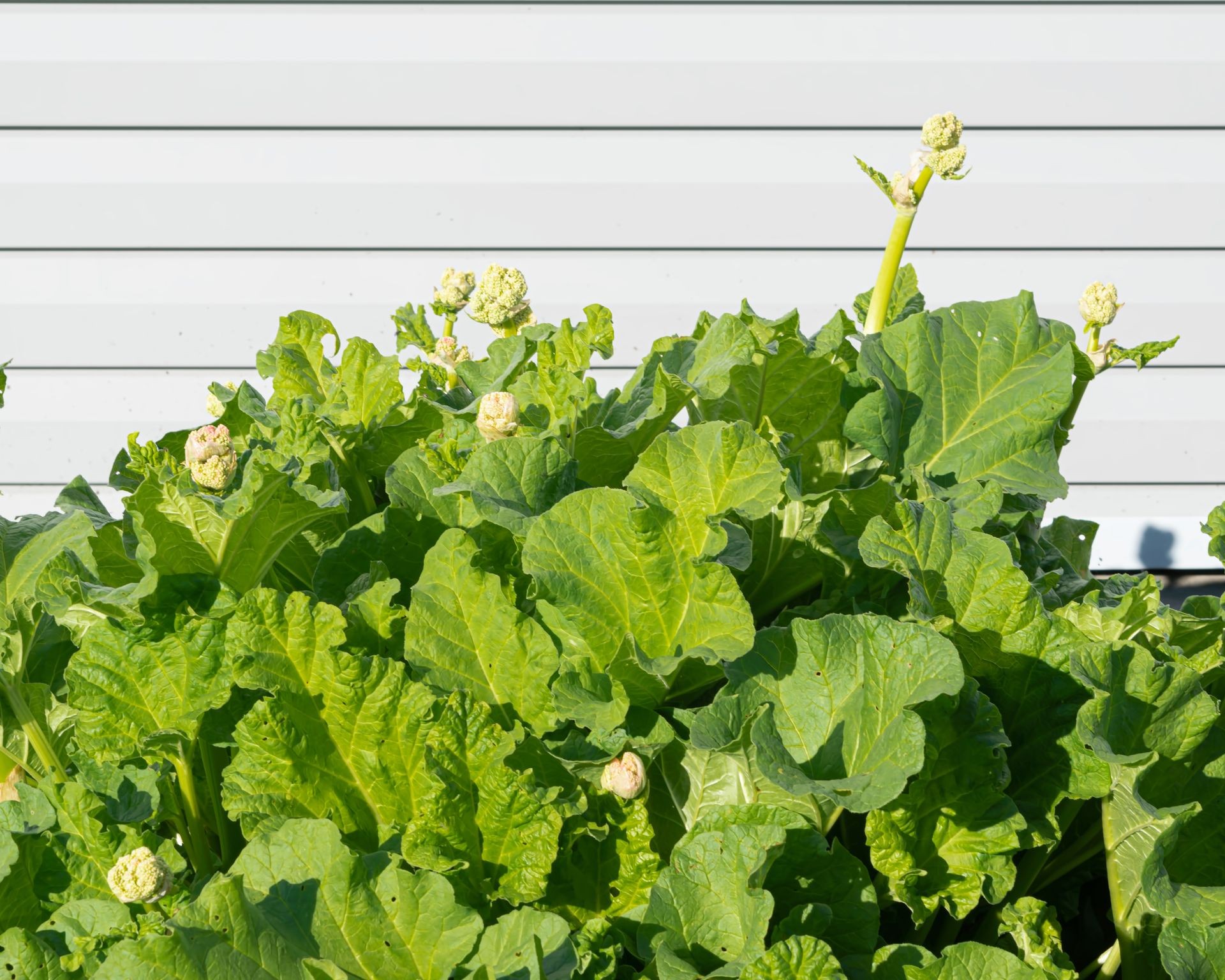No products in the cart.
NEWS
Rhubarb Flowering: Why It Happens and How to Handle It
For many home gardeners, the sight of vibrant red rhubarb stalks pushing through the soil is a welcome sign of spring. We anticipate the tangy flavor they’ll add to pies, crumbles, and sauces. But sometimes, alongside those familiar stems, something else emerges: a tall, strange-looking stalk topped with what resembles an alien cauliflower. This is a rhubarb flower, and its appearance can often raise questions, even for seasoned growers.
Why is my rhubarb flowering? Is it a problem? Should I just let it happen? As someone who has spent many seasons nurturing these productive plants in my own garden plots, I understand the concern. Flowering in rhubarb, also known as bolting, is a natural part of the plant’s life cycle, but it often signals something specific about the plant or its environment. More importantly, it impacts the harvest you were hoping for. Let’s explore why rhubarb bolts and what you can do about it.
What Do Rhubarb Flowers Look Like?
If you’ve seen a rhubarb flower stalk, you know it’s hard to miss. Unlike the thick, edible leaf stalks we harvest, the flower stalk shoots up from the center of the plant, growing significantly taller than the surrounding foliage. Initially, the flower cluster at the top might appear compact and resemble a malformed head of broccoli or cauliflower, often with a pinkish or reddish tinge.
 Close-up view of developing rhubarb flower clusters showing their unique texture and pink tinge.
Close-up view of developing rhubarb flower clusters showing their unique texture and pink tinge.
As the stalk elongates and the flower head matures, it expands into a large, feathery panicle. These panicles are typically creamy white and quite prominent, looking somewhat like an oversized Astilbe bloom. While they have a certain ornamental appeal, their presence signifies that the plant is putting its energy into reproduction rather than producing those delicious, fleshy stems we crave.
Why Does Rhubarb Flower (Bolt)?
Flowering is a fundamental part of most plants’ reproductive strategy – it’s how they produce seeds to create the next generation. Rhubarb is no exception. However, when we grow rhubarb, we’re typically interested in the leaf stalks, not the seeds. Bolting diverts the plant’s energy away from stalk production.
Understanding the reasons behind bolting helps you keep your rhubarb patch healthy and productive. While sometimes it’s simply a sign of maturity, other times it can indicate environmental factors or a need for specific care. Here are the most common culprits:
Reason 1: Maturity and Age
One of the most frequent reasons for rhubarb to flower is simply that it has reached maturity. Rhubarb plants need a few years after planting to become well-established. Once they are mature, typically after 2-3 years, they have the capacity to flower and set seed as part of their natural life cycle.
Older plants are more likely to bolt consistently. Rhubarb can live for 10 to 20 years or even longer under ideal conditions, providing many seasons of harvest. If your established rhubarb plant sends up a flower stalk each year, it’s often just a sign of its age and maturity. It’s ready to reproduce.
Reason 2: Variety Matters
Just like different varieties of other vegetables have different traits (some tomatoes are better for saucing, some lettuces are slower to bolt in heat), certain rhubarb varieties are naturally more prone to flowering than others.
Traditional heirloom varieties, while beloved for their flavor or other characteristics, can sometimes be more inclined to produce seed stalks. Modern cultivars have often been bred for specific traits, including a reduced tendency to bolt. If you’re growing an older variety, annual flowering might be normal for that type. Choosing a slow-bolting variety when planting can help minimize this issue from the start.
Reason 3: Heat and Environmental Stress
Rhubarb is a cool-season crop, thriving in climates with cold winters that provide a necessary dormancy period and relatively mild springs and summers. High temperatures are a major trigger for bolting. When the weather heats up significantly, especially if it happens rapidly in late spring or early summer, the rhubarb plant can perceive this as a signal to hurry up and reproduce before conditions become too unfavorable.
Temperatures consistently above 75°F (24°C) can encourage flowering, and this tendency increases considerably when temperatures climb closer to or above 90°F (32°C). If your region experiences unusually hot springs or you live in a warmer climate, heat stress is a likely cause of bolting.
 Tall, mature rhubarb flower stalks standing prominently in a home vegetable garden, potentially due to heat stress.
Tall, mature rhubarb flower stalks standing prominently in a home vegetable garden, potentially due to heat stress.
Managing heat stress is key in warmer areas. Applying a thick layer (2-3 inches or 5-7.5 cm) of organic mulch around the base of the plant helps keep the soil cooler. If your rhubarb is located in a spot that gets intense afternoon sun in a hot climate, consider relocating it to a site that offers some shade during the hottest part of the day.
Reason 4: General Plant Stress
Beyond just heat, various other forms of stress can cause a rhubarb plant to bolt. When a plant feels threatened – whether by drought, nutrient deficiency, pest attacks, disease, or physical damage – its evolutionary instinct is to ensure the continuation of its species. This often means attempting to reproduce as quickly as possible by sending up a flower stalk and setting seed.
Think of it as the plant panicking. If conditions are bad and it might not survive, its priority shifts from growing tasty stalks to producing seeds for the future. Common stressors include:
- Lack of Water: Rhubarb needs consistent moisture, especially during dry spells.
- Nutrient Deficiency: Poor soil or lack of feeding can stress the plant.
- Pests or Diseases: Significant infestations or infections weaken the plant.
- Crowding: Competition from weeds or other plants for resources.
Ensuring your rhubarb has adequate water, receives balanced nutrients (a light feeding in spring is often beneficial), is kept weed-free, and is protected from significant pest damage helps reduce stress and the likelihood of premature bolting.
Reason 5: Overdue for Division
Closely related to age and maturity, a rhubarb clump that has grown large and dense over many years without being divided can become stressed and more prone to flowering. The plant becomes crowded, competing with itself for limited resources in the soil.
Dividing rhubarb every 5-10 years rejuvenates the plant, improves vigor, and often reduces the tendency to bolt. In my experience, established plants that start flowering more frequently are often signaling that it’s time for division. Also, rhubarb grown directly from seed is sometimes more genetically variable and can show a stronger tendency to flower early compared to plants propagated vegetatively (from divisions).
 Detailed close-up of a fully opened rhubarb flower panicle, showcasing its creamy-white florets.
Detailed close-up of a fully opened rhubarb flower panicle, showcasing its creamy-white florets.
The best time to divide rhubarb is typically in early spring before growth begins. You dig up the entire crown, cut it into sections using a sharp spade or knife, ensuring each section has at least one large bud (or ‘eye’) and a good root system, and then replant these sections in freshly amended soil.
Should You Let Your Rhubarb Flower?
While letting a rhubarb plant flower is not inherently harmful to the plant itself, it’s generally not recommended if your primary goal is to harvest the leaf stalks for eating.
Here’s why: The plant has a finite amount of energy. When it puts that energy into producing a large flower stalk and eventually seeds, it diverts resources away from developing thick, juicy, edible stems. You’ll likely get fewer stalks, and the stalks you do get might be thinner or less vigorous if the flower is left to mature.
For most gardeners, the priority is a bountiful harvest of stems. Therefore, the common practice is to remove the flower stalk as soon as it is spotted. This signals the plant to redirect its energy back into vegetative growth – growing more leaves and expanding the crown, which in turn leads to more and larger edible stalks.
Even if your plant has flowered, the existing stalks are still perfectly safe to harvest and eat (remembering that only the stems are edible, not the leaves or flower stalk). However, removing the flower will encourage better stem production going forward.
How to Remove Rhubarb Flower Stalks
Removing a rhubarb flower stalk is a simple task. The key is to do it as soon as you notice it emerging.
Use a sharp, clean knife or a pair of pruning shears. Follow the flower stalk down from the top all the way to where it originates from the crown at the base of the plant. Cut the stalk off cleanly about an inch (roughly 2.5 cm) above the crown.
Removing the entire stalk prevents the plant from continuing to channel energy into its development and encourages it to focus back on producing those valuable edible stems.
 Healthy, large rhubarb plants with multiple flower stalks, illustrating active bolting in the patch.
Healthy, large rhubarb plants with multiple flower stalks, illustrating active bolting in the patch.
Finding a rhubarb plant that has bolted doesn’t have to be a cause for alarm. By understanding the common reasons behind it – whether it’s natural maturity, environmental stress, or a need for maintenance like division – you can take appropriate steps. Removing the flower stalk is usually the best course of action to ensure a good harvest, allowing you to continue enjoying the unique, tart flavor of fresh rhubarb from your own garden.
Frequently Asked Questions (FAQs)
Gardeners often have specific questions when they see their rhubarb flowering for the first time. Here are answers to some of the most common ones:
Is rhubarb still good after it flowers?
Yes, absolutely. The flowering process itself does not render the edible stalks unusable or change their flavor or texture in the way that bolting makes leafy greens like spinach or lettuce bitter. You can safely harvest and eat the leaf stalks even if a flower stalk is present. However, as mentioned, removing the flower stalk is recommended to encourage the plant to produce more and larger edible stems.
Is flowering rhubarb poisonous?
It’s crucial to be clear about which part of the rhubarb plant is poisonous. The leaves of the rhubarb plant contain high levels of oxalic acid and are toxic; they should never be eaten. The flower stalk also contains higher concentrations of oxalic acid than the leaf stems and is generally considered toxic and should not be consumed. The tiny flowers themselves are not toxic, but they are very sour and not pleasant to eat. The part we eat – the thick, colorful leaf stems or petioles – are safe to consume, raw or cooked. Historically, people first tried eating rhubarb leaves, which unfortunately led to illness before they discovered the edible stems.
Where exactly do you cut off rhubarb flowers?
To remove a rhubarb flower stalk, follow it down from the top until you reach the base where it emerges from the crown of the plant. Make a clean cut with a sharp tool (like pruning shears or a knife) about an inch (around 2.5 cm) above the point where it attaches to the crown. This removes the entire flowering structure and encourages the plant’s energy to return to vegetative growth.



